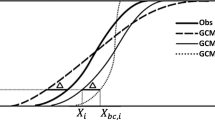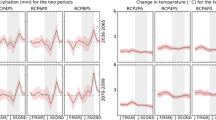Abstract
Uncertainty in climate change impact studies can be identified in general circulation models (GCM), emission scenarios, downscaling techniques, hydrological models and data. Despite being aleatory or epistemic -sourced uncertainties, their effect size on impact model output can be variable in different climate zones. To test this hypothesis, the present study explored the uncertainty level of each source in the projected streamflow scenarios of the Sarbaz river basin (SRB) with arid climate properties and the tropical Hulu Langat river basin (HLB). An ensemble of five GCMs bias-corrected using EquiDistant-CDF-matching method, two representative concentration pathways (RCPs), and hydrological model parameters sets sourced the overall uncertainty in each case study. Investigations were performed at mean monthly scale of three 30-year periods of baseline, 2016–2045 (2030s), and 2046–2075 (2060s). In both climates, on average, GCM uncertainty was the largest contributor at monthly scale analysis and its effect size escalated following the monsoon months. In the tropical HLB, GCM uncertainty increased across the periods, but it did not show a similar pattern in the arid region of SRB. The RCP uncertainty showed the least effect size during the baseline period and it peaked in 2030s in the HLB climate. However, the only pattern recognizable in the arid SRB was the intensified effect size of all uncertainty sources along with the tremendous impacts projected in monsoon months; at least twice the size of uncertainty sources effect and impacts projected for the tropical HLB. The uncertainty sources effect size altered dramatically as the climate—of the study area—changed. Thus, this research emboldens the need for seasonal-based analysis of uncertainty sources in climate change impact studies at dry climate zones.





Similar content being viewed by others
References
Abbaspour KC, Faramarzi M, Ghasemi SS, Yang H (2009) Assessing the impact of climate change on water resources in Iran. Water Resour Res 45. https://doi.org/10.1029/2008WR007615
Abbaspour KC, AshrafVaghefi S, Yang H, Srinivasan R (2019) Global soil , landuse , evapotranspiration , historical and future weather databases for SWAT Applications. Sci Data 6:1–11. https://doi.org/10.1038/s41597-019-0282-4
Brigode P, Oudin L, Perrin C (2013) Hydrological model parameter instability: a source of additional uncertainty in estimating the hydrological impacts of climate change? J Hydrol 476:410–425. https://doi.org/10.1016/j.jhydrol.2012.11.012
Chen J, Brissette FP, Chaumont D, Braun M (2013) Performance and uncertainty evaluation of empirical downscaling methods in quantifying the climate change impacts on hydrology over two north American river basins. J Hydrol 479:200–214
Das J, Treesa A, Umamahesh NV (2018) Modelling impacts of climate change on a River Basin: analysis of uncertainty using REA & Possibilistic approach. Water Resour Manag 32:4833–4852. https://doi.org/10.1007/s11269-018-2046-x
De Niel J, Van Uytven E, Willems P (2019) Uncertainty analysis of climate change impact on river flow extremes based on a large multi-model ensemble. Water Resour Manag 33:4319–4333. https://doi.org/10.1007/s11269-019-02370-0
Devak M, Dhanya CT (2014) Downscaling of Precipitation in Mahanadi Basin , India. Int J Civ Eng Res 5:111–120
Ebrahimian M, Nuruddin AA, Soom MAM, Sood AM, Neng LJ, Galavi H (2018) Trend analysis of major hydroclimatic variables in the Langat River basin. Malaysia Singap J Trop Geogr 39:192–214. https://doi.org/10.1111/sjtg.12234
Galavi H, Lee TS (2012) Uncertainty analysis of climate change impacts on runoff. In: International Conference on Future Environment and Energy. pp 235–239
Galavi H, Kamal MR, Mirzaei M, Ebrahimian M (2019) Assessing the contribution of different uncertainty sources in streamflow projections. Theor Appl Climatol 137:1289–1303. https://doi.org/10.1007/s00704-018-2669-0
Jeon S, Paciorek CJ, Wehner MF (2016) Quantile-based bias correction and uncertainty quantification of extreme event attribution statements. Weather Clim Extrem 24–32. https://doi.org/10.1016/j.wace.2016.02.001
Kriauciuniene J, Jakimavicius D, Sarauskiene D, Kaliatka T (2013) Estimation of uncertainty sources in the projections of Lithuanian river runoff. Stoch Environ Res Risk Assess 27:769–784. https://doi.org/10.1007/s00477-012-0608-7
Kundzewicz ZW, Krysanova V, Benestad RE, Hov Ø, Piniewski M, Otto IM (2018) Uncertainty in climate change impacts on water resources. Environ Sci Pol 79:1–8. https://doi.org/10.1016/j.envsci.2017.10.008
Latif M (2011) Uncertainty in climate change projections. J Geochemical Explor 110:1–7. https://doi.org/10.1016/j.gexplo.2010.09.011
Lee TS, Galavi H, Huang YF (2014) Uncertainty in climate change impact studies: a general picture. Int J Clim Chang Impacts Responses 6:
Lespinas F, Ludwig W, Heussner S (2014) Hydrological and climatic uncertainties associated with modeling the impact of climate change on water resources of small Mediterranean coastal rivers. J Hydrol 511:403–422. https://doi.org/10.1016/j.jhydrol.2014.01.033
Li H, Sheffield J, Wood EF (2010) Bias correction of monthly precipitation and temperature fields from intergovernmental panel on climate change AR4 models using equidistant quantile matching. J Geophys Res Atmos 115. https://doi.org/10.1029/2009JD012882
Liu Y, Zhang J, Wang G, Liu J, He R, Wang H, Liu C, Jin J (2012) Quantifying uncertainty in catchment-scale runoff modeling under climate change (case of the Huaihe River, China). Quat Int 282:130–136
McSweeney CF, Jones RG, Lee RW, Rowell DP (2015) Selecting CMIP5 GCMs for downscaling over multiple regions. Clim Dyn 44:3237–3260. https://doi.org/10.1007/s00382-014-2418-8
Mirzaei M, Galavi H, Faghih M, Huang YF, Lee TS, el-Shafie A (2013) Model calibration and uncertainty analysis of runoff in the Zayanderood River basin using generalized likelihood uncertainty estimation (GLUE) method. J Water Supply Res Technol 62:309–321
Mirzaei M, Huang YF, El-Shafie A, Shatirah A (2015) Application of the generalized likelihood uncertainty estimation (GLUE) approach for assessing uncertainty in hydrological models: a review. Stoch Environ Res Risk Assess 29:1265–1273. https://doi.org/10.1007/s00477-014-1000-6
Moriasi D, Arnold J (2007) Model evaluation guidelines for systematic quantification of accuracy in watershed simulations. Am Soc Agric biol Eng 50:885–900. https://doi.org/10.13031/2013.23153
MOSTI (2015) General climate of Malaysia. In: Minist. Sci. Technolgy Innov. http://www.met.gov.my/index.php. Accessed 21 Aug 2015
Najafi R, Hessami Kermani MR (2017) Uncertainty modeling of statistical downscaling to assess climate change impacts on temperature and precipitation. Water Resour Manag 31:1843–1858. https://doi.org/10.1007/s11269-017-1615-8
Park J, Park M, Ahn S et al (2011) Assessment of future climate change impacts on water quantity and quality for a mountainous dam watershed using SWAT. Am Soc Agric Biol Eng 54:1725–1737. https://doi.org/10.1007/s10333-014-0471-x
Pechlivanidis IG, Arheimer B, Donnelly C, Hundecha Y, Huang S, Aich V, Samaniego L, Eisner S, Shi P (2017) Analysis of hydrological extremes at different hydro-climatic regimes under present and future conditions. Clim Chang 141:467–481. https://doi.org/10.1007/s10584-016-1723-0
Phillips NA (1956) The general circulation of the atmosphere: a numerical experiment. Q J R Meteorol Soc 82:123–164. https://doi.org/10.1002/qj.49708235202
Prudhomme C, Davies H (2007) Comparison of different sources of uncertainty in climate change impact studies in Great Britain. In: Technical Document in Hydrology-UNESCO. Paris, pp 183–190
Rajaud A, de Noblet-Ducoudré N (2017) Tropical semi-arid regions expanding over temperate latitudes under climate change. Clim Chang 144:703–719. https://doi.org/10.1007/s10584-017-2052-7
Ruan Y, Liu Z, Wang R, Yao Z (2019) Assessing the performance of CMIP5 GCMs for projection of future temperature change over the lower Mekong Basin. Atmosphere (Basel) 10:93. https://doi.org/10.3390/atmos10020093
Shashikanth K, Ghosh S (2013) Fine resolution indian summer monsoon rainfall projection with statistical downscaling. Int J Chem Environ Biol Sci 1:
Thompson JR, Green AJ, Kingston DG, Gosling SN (2013) Assessment of uncertainty in river flow projections for the Mekong River using multiple GCMs and hydrological models. J Hydrol 486:1–30
Tian Y, Booij M, Zhu Q et al (2013) Uncertainties of the extreme high flows under climate change impact due to emission scenarios , hydrological models and parameters. Geophys Res Abstr 15:2013
Trzaska S, Schnarr E (2014) A review of downscaling methods for climate change projections. United States Agency for International Development, Washington, D.C
Vidal J-P, Wade SD (2008) Multimodel projections of catchment-scale precipitation regime. J Hydrol 353:143–158. https://doi.org/10.1016/j.jhydrol.2008.02.003
Wang L, Chen W (2013) A CMIP5 multimodel projection of future temperature, precipitation, and climatological drought in China. Int J Climatol 2078:2059–2078. https://doi.org/10.1002/joc.3822
Acknowledgements
This research was possible through the grant number of “UOZ-GR-9618-144” that authors received from the University Of Zabol.
Author information
Authors and Affiliations
Corresponding author
Additional information
Publisher’s Note
Springer Nature remains neutral with regard to jurisdictional claims in published maps and institutional affiliations.
Rights and permissions
About this article
Cite this article
Galavi, H., Mirzaei, M. Analyzing Uncertainty Drivers of Climate Change Impact Studies in Tropical and Arid Climates. Water Resour Manage 34, 2097–2109 (2020). https://doi.org/10.1007/s11269-020-02553-0
Received:
Accepted:
Published:
Issue Date:
DOI: https://doi.org/10.1007/s11269-020-02553-0




